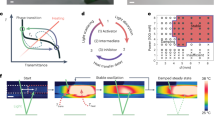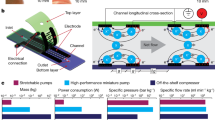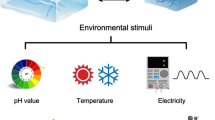Abstract
To mitigate the adverse effects of elevated temperatures, conventional rigid devices use bulky radiators, heat sinks and fans to dissipate heat from sensitive components. Unfortunately, these thermoregulation strategies are incompatible with soft robots, a growing field of technology that, like biology, builds compliant and highly deformable bodies from soft materials to enable functional adaptability. Here, we design fluidic elastomer actuators that autonomically perspire at elevated temperatures. This strategy incurs operational penalties (i.e., decreased actuation efficiency and loss of hydraulic fluid) but provides for thermoregulation in soft systems. In this bioinspired approach, we 3D-print finger-like actuators from smart gels with embedded micropores that autonomically dilate and contract in response to temperature. During high-temperature operation, the internal hydraulic fluid flows through the dilated pores, absorbs heat and vaporizes. Upon cooling, the pores contract to restrict fluid loss and restore operation. To assess the thermoregulatory performance, this protocol uses non-invasive thermography to measure the local temperatures of the robot under varied conditions. A mathematical model based on Newton’s law of cooling quantifies the cooling performance and enables comparison between competing designs. Fabrication of the sweating actuator usually takes 3–6 h, depending on size, and can provide >100 W/kg of additional cooling capacity.
This is a preview of subscription content, access via your institution
Access options
Access Nature and 54 other Nature Portfolio journals
Get Nature+, our best-value online-access subscription
$29.99 / 30 days
cancel any time
Subscribe to this journal
Receive 12 print issues and online access
$259.00 per year
only $21.58 per issue
Buy this article
- Purchase on Springer Link
- Instant access to full article PDF
Prices may be subject to local taxes which are calculated during checkout







Similar content being viewed by others
Data availability
The data used in this protocol are available in the supporting primary research article, and the design files are accessible at https://doi.org/10.6084/m9.figshare.12964811.
Software availability
The MATLAB code used in this protocol can be found in the Supplementary Information.
References
Kim, S., Laschi, C. & Trimmer, B. Soft robotics: a bioinspired evolution in robotics. Trends Biotechnol. 31, 287–294 (2013).
Trivedi, D., Rahn, C. D., Kier, W. M. & Walker, I. D. Soft robotics: biological inspiration, state of the art, and future research. Appl. Bionics Biomech. 5, 99–117 (2008).
Laschi, C., Mazzolai, B. & Cianchetti, M. Soft robotics: technologies and systems pushing the boundaries of robot abilities. Sci. Robot. 1, eaah3690 (2016).
Laschi, C. & Cianchetti, M. Soft robotics: new perspectives for robot bodyware and control. Front. Bioeng. Biotechnol. 2, 3 (2014).
Ilievski, F., Mazzeo, A. D., Shepherd, R. F., Chen, X. & Whitesides, G. M. Soft robotics for chemists. Angew. Chem. Int. Ed. Engl. 50, 1890–1895 (2011).
Iida, F. & Laschi, C. Soft robotics: challenges and perspectives. Procedia Compute. Sci. 7, 99–102 (2011).
Highton, H. Perpetual motion. Nature 3, 368–369 (1871).
Shepherd, R. F. et al. Using explosions to power a soft robot. Angew. Chem. Int. Ed. Engl. 52, 2892–2896 (2013).
Marchese, A. D., Onal, C. D. & Rus, D. Towards a self-contained soft robotic fish: on-board pressure generation and embedded electro-permanent magnet valves. in Experimental Robotics Vol. 88 (eds. Desai, J. et al.) 41–54 (Springer, 2013).
Bartlett, N. W. et al. A 3D-printed, functionally graded soft robot powered by combustion. Science 349, 161–165 (2015).
Miriyev, A., Stack, K. & Lipson, H. Soft material for soft actuators. Nat. Commun. 8, 1–8 (2017).
Yirmibeşoğlu, O. D., Oshiro, T., Olson, G., Palmer, C. & Mengüç, Y. Evaluation of 3D printed soft robots in radiation environments and comparison with molded counterparts. Front. Robot. AI 6, 40 (2019).
Tolley, M. T. et al. A resilient, untethered soft robot. Soft Robot. 1, 213–223 (2014).
Shepherd, R. F. et al. Multigait soft robot. Proc. Natl Acad. Sci. USA 108, 20400–20403 (2011).
Grady, J. M., Enquist, B. J., Dettweiler-Robinson, E., Wright, N. A. & Smith, F. A. Evidence for mesothermy in dinosaurs. Science 344, 1268–1272 (2014).
Wright, P. Why do elephants flap their ears? Afr. Zool. 19, 266–269 (1984).
Farlow, J. O., Thompson, C. V. & Rosner, D. E. Plates of the dinosaur Stegosaurus: forced convection heat loss fins? Science 192, 1123–1125 (1976).
Kotagama, P., Phadnis, A., Manning, K. C. & Rykaczewski, K. Rational design of soft, thermally conductive composite liquid‐cooled tubes for enhanced personal, robotics, and wearable electronics cooling. Adv. Mater. Technol. 4, 1800690 (2019).
Morin, S. A. et al. Camouflage and display for soft machines. Science 337, 828–832 (2012).
VII. Scala graduum caloris. Philos. Trans. R. Soc. Lond. 22, 824–829 (1701).
Padilla, L. R. & Hilton, C. D. Canidae. in Fowler’s Zoo and Wild Animal Medicine Vol. 8 (eds. Miller, R. F. & Fowler, M. E.) 457–466 (Elsevier Saunders, 2015).
Calder, W. A. & Schmidt-Nielsen, K. Temperature regulation and evaporation in the pigeon and the roadrunner. Am. J. Physiol. 213, 883–889 (1967).
Dawson, W. R. Evaporative losses of water by birds. Comp. Biochem. Physiol. A Physiol. 71, 495–509 (1982).
Dawson, M. E., Schell, A. M., Beers, J. R. & Kelly, A. Allocation of cognitive processing capacity during human autonomic classical conditioning. J. Exp. Psychol. Gen. 111, 273–295 (1982).
Whitfield, M. C., Smit, B., McKechnie, A. E. & Wolf, B. O. Avian thermoregulation in the heat: scaling of heat tolerance and evaporative cooling capacity in three southern African arid-zone passerines. J. Exp. Biol. 218, 1705–1714 (2015).
Ingram, D. Evaporative cooling in the pig. Nature 207, 415–416 (1965).
Sawka, M. N., Wenger, C. B. & Pandolf, K. B. Thermoregulatory responses to acute exercise‐heat stress and heat acclimation. Compr. Physiol 14 (Suppl.), 157–185 (2011).
Johnson, J. & Proppe, D. Body fluid balance during heat stress in humans. in Handbook of Physiology, Section 4: Environmental Physiology (eds. Fregly, M. J. & Blatteis, C. M.) 189–214 (Oxford University Press, 1996).
Hodgson, D. et al. Dissipation of metabolic heat in the horse during exercise. J. Appl. Physiol. 74, 1161–1170 (1993).
Kalairaj, M. S., Banerjee, H., Lim, C. M., Chen, P.-Y. & Ren, H. Hydrogel-matrix encapsulated Nitinol actuation with self-cooling mechanism. RSC Adv. 9, 34244–34255 (2019).
Kozuki, T. et al. Skeletal structure with artificial perspiration for cooling by latent heat for musculoskeletal humanoid kengoro. in 2016 IEEE/RSJ International Conference on Intelligent Robots and Systems (IROS) 2135–2140 (IEEE, 2016).
Asano, Y., Okada, K. & Inaba, M. Design principles of a human mimetic humanoid: humanoid platform to study human intelligence and internal body system. Sci. Robot. 2, eaaq0899 (2017).
Mishra, A. K. et al. Autonomic perspiration in 3D-printed hydrogel actuators. Sci. Robot. 5, eaaz3918 (2020).
Banerjee, H., Suhail, M. & Ren, H. Hydrogel actuators and sensors for biomedical soft robots: brief overview with impending challenges. Biomimetics (Basel) 3, 15 (2018).
Fan, H. & Gong, J. P. Fabrication of bioinspired hydrogels: challenges and opportunities. Macromolecules 53, 2769–2782 (2020).
Wallin, T., Pikul, J. & Shepherd, R. 3D printing of soft robotic systems. Nat. Rev. Mater. 3, 84–100 (2018).
Holback, H., Yeo, Y. & Park, K. Hydrogel swelling behavior and its biomedical applications. in Biomedical Hydrogels: Biochemistry, Manufacture and Medical Applications (ed. Rimmer, S.) 3–24 (Woodhead Publishing, 2011).
Ebara, M. et al. Smart Biomaterials (Springer, 2014).
Yuk, H. et al. Hydraulic hydrogel actuators and robots optically and sonically camouflaged in water. Nat. Commun. 8, 1–12 (2017).
Ge, Q. et al. Multimaterial 4D printing with tailorable shape memory polymers. Sci. Rep. 6, 31110 (2016).
Odent, J. et al. Highly elastic, transparent, and conductive 3D‐printed ionic composite hydrogels. Adv. Funct. Mater. 27, 1701807 (2017).
Wallin, T. et al. Click chemistry stereolithography for soft robots that self-heal. J. Mater. Chem. B 5, 6249–6255 (2017).
Peele, B. N., Wallin, T. J., Zhao, H. & Shepherd, R. F. 3D printing antagonistic systems of artificial muscle using projection stereolithography. Bioinspir. Biomim. 10, 055003 (2015).
Hunter, J. Observations on Certain Parts of the Animal Economy (Lyon Public Library, 1792).
Taylor, C. R. Strategies of temperature regulation: effect on evaporation in East African ungulates. Am. J. Physiol. 219, 1131–1135 (1970).
Ohhashi, T., Sakaguchi, M. & Tsuda, T. Human perspiration measurement. Physiol. Meas. 19, 449–461 (1998).
Kingston, J., Geor, R. & McCutcheon, L. Use of dew-point hygrometry, direct sweat collection, and measurement of body water losses to determine sweating rates in exercising horses. Am. J. Vet. Res. 58, 175–181 (1997).
Flir E4 Brochure. https://www.flir.com/globalassets/imported-assets/document/ex-series-no-wifi-datasheet.pdf (2020).
Bennett, J. Measuring UV curing parameters of commercial photopolymers used in additive manufacturing. Addit. Manuf. 18, 203–212 (2017).
Mishra, A. K. P., Wenyang, P., Giannelis, E. P., Shepherd, R. F. & Wallin, T. J. Stl files for 3D printed Sweating actuators 09/17/2020 edn. https://figshare.com/articles/dataset/Stl_files_for_3D_printed_Sweating_actuators/12964811 (2020).
ASTM International. Standard Test Method for Determining Specific Heat Capacity by Differential Scanning Calorimetry (ASTM International, 2011).
Rajput, R. Heat and Mass Transfer in SI Units 98–99 (S. Chand, 2008).
Incropera, F. P., DeWitt, D. P., Bergman, T. L. & Lavine, A. S. Fundamentals of Heat and Mass Transfer (Wiley, 2007).
Nag, P. Engineering Thermodynamics (Tata McGraw-Hill Education, 2013).
Acknowledgements
This research was supported in part by the Office of Naval Research Young Investigator Program (N00014-17-1-2837). This work made use of the Cornell Center for Materials Research Shared Facilities, which are supported through the NSF MRSEC program (DMR-1719875).
Author information
Authors and Affiliations
Contributions
A.K.M., W.P., and T.J.W. developed the protocol. E.P.G. and R.F.S. obtained resources to support this research effort. A.K.M. and T.J.W. generated figures and took the lead in writing the manuscript with support from W.P., E.P.G. and R.F.S.
Corresponding author
Ethics declarations
Competing interests
The authors declare no competing interests.
Additional information
Peer review information Nature Protocols thanks Dacheng Wei and the other, anonymous, reviewer(s) for their contribution to the peer review of this work.
Publisher’s note Springer Nature remains neutral with regard to jurisdictional claims in published maps and institutional affiliations.
Related links
Key reference using this protocol
Mishra, A. et al. Sci. Robot. 5, eaaz3918 (2020): https://doi.org/10.1126/scirobotics.aaz3918
Supplementary information
Supplementary Information
MATLAB code and Supplementary Figs. 1–12.
Rights and permissions
About this article
Cite this article
Mishra, A.K., Pan, W., Giannelis, E.P. et al. Making bioinspired 3D-printed autonomic perspiring hydrogel actuators. Nat Protoc 16, 2068–2087 (2021). https://doi.org/10.1038/s41596-020-00484-z
Received:
Accepted:
Published:
Issue Date:
DOI: https://doi.org/10.1038/s41596-020-00484-z
This article is cited by
Comments
By submitting a comment you agree to abide by our Terms and Community Guidelines. If you find something abusive or that does not comply with our terms or guidelines please flag it as inappropriate.



